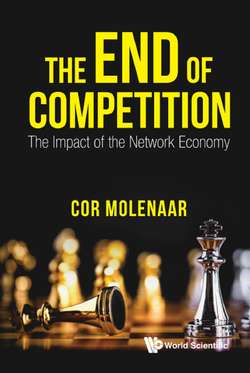Читать книгу End Of Competition, The: The Impact Of The Network Economy - C N A Molenaar - Страница 31
На сайте Литреса книга снята с продажи.
So What is the New Supply Chain Then?
ОглавлениеThe traditional supply chain involved a linear process, where successive links added value. Each link was independent, and had its own revenue model and position. The totality of these independent links was the supply chain. Information was passed on from link to link. As a result, factories had limited information regarding customers, buying processes and buying motives. The customers of a manufacturer were the companies of the next link in the chain, not the end customer. This was typical for the traditional analogue approach, but was a major limitation if you needed to respond to a dynamic market.
Table 1. Overview of value creation, old and new.
| Porter’s Five Forces Model | Traditional | Network Based |
| Substitute of products | Competing on the basis of quality and experience. | Ensuring there is a powerful network with complementary products and suppliers. |
| Entrants | Erecting barriers based on local position, price, speedy deliveries, distribution and presence. | Ensuring there is added value and possible balloting for new entrants. Providing customer loyalty. |
| Negotiating power of supplier | Limited number of providers, with attention on the competitors and a distinctive supply. | Choices based on needs and wishes. Price is only one component. |
| Negotiating power of customers | Ensuring there is a unique product, effective distribution channel with limited negotiation freedom (for example, prices). | Based on needs and wishes. Customer provides a basis for matching. |
| Rivalry in the market | Market position and market share form the basis. A clear focus on other providers/competitors. | Via the network but based on the filtering in the matching module. |
By using networks, platforms, a totally different model arises: the supply chain ecosystem. Here, all parties work together in a network that forms dynamically. Each collaboration is different, but in all cases the information is shared. This is typical for a platform where a match develops between providers and consumers. There is a much greater understanding of the buying motives and customer preferences. Certain links in the chain even become redundant as the function is taken over by other parties. Are shops still needed if manufacturers and wholesalers can supply customers directly? Platforms and networks lead to a disintermediation, or implosion, of a supply chain. Each party has to determine its added value in the ecosystem all over again. Information leads to transparency, so there is a better response to the demand. As a result of this transparency, as well as the direct relationship, customers are better able to gear the demand to the supply. In addition, the costs associated with an ecosystem, the network, will be lower than in a linear supply chain. There are, after all, fewer parties involved, and therefore fewer costs and lucrative links. The final price will consequently be lower or better attuned to the dynamics in the market. Dynamic pricing is an example of this: a price that depends on customer demand.
